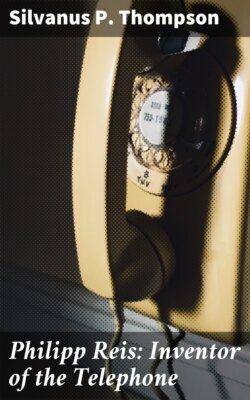Читать книгу Philipp Reis: Inventor of the Telephone - Silvanus P. Thompson - Страница 24
На сайте Литреса книга снята с продажи.
III.—Reis’s Telephone will transmit speech.
ОглавлениеTable of Contents
Reis’s Telephone consists of two parts: a “transmitter,” into which the speaker speaks; and a “receiver,” at which the hearer listens. Their various forms have been described in detail in the preceding chapter. All that we are concerned with at this place is, whether these instruments will at the present day do what is asserted. The writer has tested every form of Reis’s transmitter, save only some of the tentative historic forms shown in Figs. 2–8, 13, 15, & 16, ante, and has found them perfectly competent to transmit speech, provided proper precautions were taken: namely, that the contacts were clean and in adjustment, that the tympanum was tightly stretched, and that the speaker did not speak too loudly:[14] in other words, that the instruments were properly used. Any one who wants not to succeed in transmitting speech with Reis’s transmitter has only to neglect these reasonable precautions. It is not, therefore, difficult to fail. The writer has also tested both the better-known forms of Reis’s receiver (Figs. 21, 22, & 23), and finds that both are perfectly competent to receive speech electrically and reproduce it audibly, both vowels and consonants being perfectly distinct and articulate, though never as loud as in more modern forms of telephone-receiver. From a steel wire, magnetised, as prescribed by Reis, by surrounding it with a coil of wire through which the current passes, the writer has obtained articulation exceeding in perfection of definition, both of vowels and of consonants, the articulation of any other telephone-receiver he has ever listened to. Perhaps it may be objected that it is difficult to listen to a steel wire. Reis met this difficulty in his own way by mounting his steel wire upon a small sounding-box to strengthen the sounds, and added a flat upper case against which the ear of the listener can be pressed, and which can be removed, or opened as a lid, when a whole audience is to hear simultaneously the tones of the instrument when working in a loud and disagreeable manner, as a transmitter of the coarser vibrations of a loudly sung melody. The lid is not wanted for this latter purpose—is an encumbrance; which, nevertheless, by its presence proves the more delicate functions of the instrument. Reis’s instructions in his ‘Prospectus,’ p. 86, are that pressing this lid down firmly upon the steel core increases the loudness of the sounds. Any one who wants not to succeed in receiving speech with Reis’s receiver has, as before, only to neglect reasonable precautions. He has only to use an imperfect or bad transmitter, or use it carelessly, or put the receiver to a sufficient distance from his ear, to attain this result. There are people who have failed to make Reis’s receiver receive.
This is not the place to discuss a doctrinaire objection sometimes raised, that it is theoretically impossible for Reis’s instruments to work. For the moment we are concerned with the practical question: Do they work? No one practically experienced in telephones, even if he should deny that Reis had any such intention, will dispute that they can now be made to transmit speech. Professor Dolbear, himself no mean authority on telephones, testifies, as quoted above (p. 41), “that the instruments would talk, and would talk well.” He would, indeed, be a bold man who would come forward to deny what can be shown any day as an experimental fact: that Reis’s Telephone will transmit speech.
We have now shown that Philipp Reis was the undisputed inventor of an instrument which he called the Telephone, which instrument can now be used to transmit speech; which was then used to transmit speech; and which was invented on purpose to transmit speech. So far the result of the examination into the facts of the case is conclusive enough. A more complete case could hardly be desired. No honest person could hesitate for want of proof, either greater in amount or more direct to the point.
Nevertheless, I propose in another section to go a little further and to prove a technical point of highest interest; namely, that there is not in the Telephone Exchanges of England to-day, any single telephone to be found in which the fundamental principles of Reis’s Telephone are not the essential and indispensable features. These considerations being, however, of a strictly technical nature, will be best considered in an Appendix. As, however, we are able to show that those instruments which are now in daily use for transmitting speech, embody the two fundamental principles upon which Reis based the instrument which he called “Das Telephon,” it would be dishonest to the memory of the deceased inventor to claim anything less than that he was the “first and true inventor” of the Telephone.
